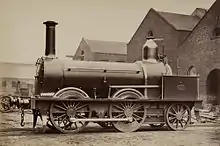Madras Railway
The Madras Railway (full name Madras Railway Company) played a pioneering role in developing railways in southern India and was merged in 1908 with Southern Mahratta Railway to form Madras and Southern Mahratta Railway.
 | |
| Industry | Railways |
|---|---|
| Founded | 8 May 1845 |
| Defunct | Merged with Southern Mahratta Railway to form Madras and Southern Mahratta Railway in 1908 |
| Headquarters | Madras (now Chennai) , |
Area served | Southern India |
| Services | Rail transport |
"As a child of its era, the railway left an indelible mark on the 19th century developments in India. In a country of continental distances, it provided the foundation for modern economic expansion by facilitating the carriage of huge quantities of passengers and freight over very long distances at hitherto unparalleled speeds. During the early part of 20th century, in a growing economy with rapid increase in demand for mobility, railway development was sparked off at a pace similar if not more marked than in Western countries in the 19th century. Development and rapid expansion of railway network in British India served as the backbone for economic growth and industrial development in the post independence era."
The Madras Railway was formed in 1845 and its first track from Royapuram in Chennai (then known as Madras) to Arcot was opened in 1856.[2][3]It had as its objective, connection of Chennai on the east coast with the west coast, as also linking up with Bengaluru and the Nilgiris, and to link up with the line from Mumbai.[2][3]
1857 from Walaja Road to Cuddalore route was proposed via Katpadi.[4] The link with the west coast was first established in 1862 with a line to Beypore, which served as the western terminus of Madras Railway. The western terminus was shifted to Khozikode (then known as Calicut) in 1888.[3]The link between Jolarpettai, a station on the Chennai-Beypore line of Madras Railway, and Bangalore Cantt. was established in 1864.[5]
In 1871, Madras Railway extension up to Raichur was linked with an extension of Great Indian Peninsula Railway from Kalyan to Raichur, thereby establishing Chennai-Mumbai link.[6] The Chennai-Vijayawada link was established in 1899, thereby paving the way for opening of the Howrah-Chennai main line.[6]
The southern part of the East Coast State Railway (from Waltair to Vijayawada) was taken over by Madras Railway in 1901.[7] Amongst the constituent railways of Madras Railway were Kolar Goldfields Railway, Nilgiri Mountain Railway and Shornapur Cochin Railway.[2]
The Madras Railway was merged with Southern Mahratta Railway in 1908 to form Madras and Southern Mahratta Railway.[8][9]
References
- "The story of Bengal Nagpur Railway (BNR) now South Eastern Railway". Anglo-India-Central. Archived from the original on 25 October 2011. Retrieved 19 February 2012.
- "Madras Railway". fibis. Retrieved 13 February 2013.
- "The Madras Railway's Western terminus". Historic Alleys. Retrieved 13 February 2013.
- Timeline of Southern Railway zone
- "IR History: Early Days – I". Chronology of railways in India, Part 2 (1832 - 1869). Retrieved 27 October 2012.
- "IR History: Early Days – II". Chronology of railways in India, Part 2 (1870 - 1899). Retrieved 27 October 2012.
- "IR History: Part III (1900-1947)". IRFCA. Retrieved 19 January 2013.
- "Third oldest railway station in country set to turn 156". Indian Railways Turn Around News. Retrieved 13 February 2013.
- Railways. The Cambridge Economic History of India, Vol 2, page 755. Orient Longmans Private Limited. 2005. ISBN 9788125027317. Retrieved 13 February 2013.